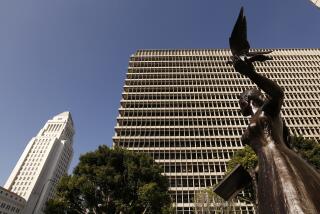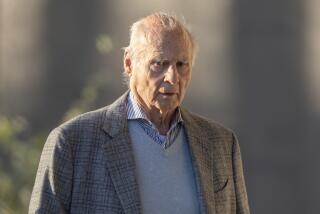Holes Seen in Case Against Andersen
- Share via
HOUSTON — A team of Justice Department officials strode into a ninth-floor federal courtroom here three weeks ago, armed with reams of paper evidence and a blue-chip witness.
But by Friday, as prosecutors neared the end of their obstruction of justice case against accounting firm Arthur Andersen, neither the documents nor star witness David B. Duncan had proved devastating to the defense, some legal experts say.
“It’s clear the government never put forth a silver bullet, and it never had any one piece of evidence that was overwhelmingly significant,” said Christopher J. Bebel, a Houston attorney and occasional consultant to the Justice Department on securities cases.
Each time prosecutors introduced an Enron Corp. e-mail or memorandum purportedly pointing toward Andersen’s culpability, Andersen defense lawyer Rusty Hardin noted that the documents were preserved, not shredded, and turned over to federal investigators under subpoena.
And under cross-examination, Duncan, the Andersen partner in charge of auditing Enron who initiated a shredding frenzy last fall, was unable to cite any specific documents or facts he intended to keep away from the Securities and Exchange Commission by destroying them.
Taken together, the testimony and evidence may cause jurors to question whether Andersen had the “corrupt” intent required to convict under the obstruction statute, said Bebel and other analysts.
“The issue as to [Andersen’s] state of mind is very much up in the air,” said Bebel, who has sat in on portions of the trial. “It looks to be more of a situation where Andersen was fumbling and bumbling, engaging in negligence perhaps, rather than the sort of egregious conduct that generally accompanies federal criminal prosecutions.”
Prosecutors still have opportunities to gain an edge, including a special conference scheduled to begin today in which the two sides will argue over the instructions U.S. District Judge Melinda Harmon will read to the jury.
Prosecutors hope to persuade Harmon to tell the jury that a partnership such as Andersen is legally bound by the acts of its officers and partners. Since Duncan has pleaded guilty to obstruction of justice, a strict interpretation of the law could mean a near-automatic conviction of Andersen.
But jurors, notoriously unpredictable, could ignore Harmon, particularly if they believe the firm has been unjustly accused or that Duncan pleaded guilty under government pressure, as Hardin has contended.
The most striking aspect of Duncan’s appearance on the witness stand was the extent to which his testimony appeared to aid equally the prosecution and the firm that fired him in January.
As head of the Andersen team that audited Enron, Duncan was aware early on of the energy trader’s financial maneuvers that ultimately led to the company’s Dec. 2 bankruptcy.
On Oct. 23, after learning that the SEC had launched an informal inquiry into Enron, Duncan testified that he instructed subordinates to comply with Andersen’s document-retention policy, which he knew would result in the destruction of some files.
But on cross-examination, Duncan said he could not recall any particular documents or facts he hoped would be hidden from the SEC.
Duncan “was unable to pinpoint specific documents he meant to keep away,” said David Berg, a veteran Houston defense attorney who has tried cases before Harmon. “And [Andersen] has shown the irrelevancy of the documents that were shredded. That is going to weigh heavily on the jury’s mind.”
Other analysts disagreed, saying that Duncan’s admission of guilt, coupled with a technical instruction from the judge that destruction of any files constitutes a crime, could tip the balance in favor of the prosecution.
“If I destroy one document with intent ... and leave everything else, that’s still obstruction of justice,” said Gerald Treece, associate dean of the South Texas College of Law, who has watched some of the proceedings.
Treece said he expected jury instructions that would favor the prosecution and added that jurors “don’t know who’s right or wrong but under our laws, you presume the lady in the black robe is right. I’m still thinking the smart money is on the government, but then again I didn’t see any defense when this case started.”
Duncan also appeared to aid the defense when he testified that he was not considering his firm’s past accounting woes at the time he ordered the destruction. Prosecutors had suggested that Andersen executives had a motive to shred Enron-related audit papers because they feared harsh sanctions that could be levied if the firm violated a cease-and-desist order it had entered to settle an SEC fraud lawsuit arising from its audits of Waste Management Inc.
Duncan not only cast doubt on that idea, but he defended much of Andersen’s Enron-related accounting. That testimony dilutes the prosecution’s claim of corrupt intent and also may weaken potential prosecutions of Enron executives for accounting fraud.
Other testimony introduced by the prosecution told how Enron’s aggressive accounting sparked disputes inside Andersen about how to treat complex financial maneuvers, and how anxiety rose at the Chicago-based accounting firm as Enron, one of its biggest clients, collapsed amid revelations of insider dealings.
All of that, prosecutors allege, prompted Andersen to at least tacitly approve widespread destruction of Enron-related documents in October.
But prosecutors presented scant evidence that the destruction had been ordered from top Andersen officials as part of a centrally coordinated scheme.
On Friday, prosecutors called their last witness, an FBI agent, to show that fears of an SEC inquiry did play a role in the destruction Oct. 23.
The agent read a transcript of testimony from Andersen partner Thomas Bauer in a civil case in which Bauer said he didn’t “recall specifically” anyone mentioning the SEC’s informal inquiry in meetings that day. Duncan testified that he did mention the SEC inquiry when he called the meeting that day. Bauer has invoked his right against self-incrimination and refused to testify.
Prosecutors also introduced notes from an internal Andersen report, which found that the deletion of e-mail by the firm’s Enron auditors increased three-fold after the October meetings.
Hardin is expected to begin presenting Andersen’s case Monday, and the jury could begin deliberating by the end of next week. His first witness is expected to be Richard Corgel, Andersen’s U.S. practice director.
“Both sides are under huge pressure,” said Berg, the Houston lawyer. “But remember, the government’s burden is ‘beyond a reasonable doubt.’ It’s not ‘maybe.’”
More to Read
Inside the business of entertainment
The Wide Shot brings you news, analysis and insights on everything from streaming wars to production — and what it all means for the future.
You may occasionally receive promotional content from the Los Angeles Times.










